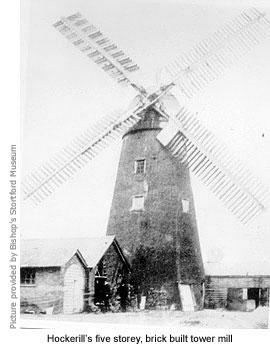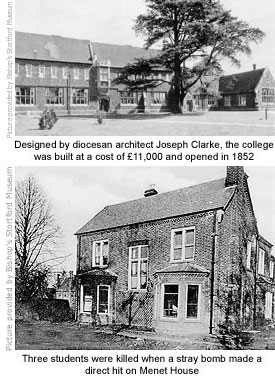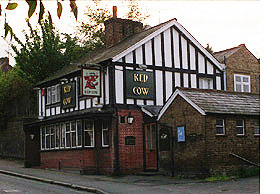|
 Since before the Conquest, Bishop’s Stortford’s unique position at the heart of vast cereal growing lands had kept its two water mills constantly busy. But by the 17th century the needs of a growing local population had to be met by the building of a third mill (See Guide 7) and it wasn’t long before London’s rapidly expanding market created an even greater need for corn from its surrounding counties. Unable to cope with the demand, the output of water mills was supplemented by windmills. Since before the Conquest, Bishop’s Stortford’s unique position at the heart of vast cereal growing lands had kept its two water mills constantly busy. But by the 17th century the needs of a growing local population had to be met by the building of a third mill (See Guide 7) and it wasn’t long before London’s rapidly expanding market created an even greater need for corn from its surrounding counties. Unable to cope with the demand, the output of water mills was supplemented by windmills.
Windmills were invented by the Arabs in the 7th century and first introduced to this country in the reign of Richard I (1189–99). Their use, however, had been minimal until the population explosion of the 1600s, and then countless windmills were built right across the country. By 1760 over 200 were operating in Essex alone. But this was the start of the Industrial Revolution and over the next hundred years their numbers, nationwide, dwindled dramatically. By 1862 only 33 were operating in Hertfordshire and in 1899 there were just seven.
One of the earliest in this area was built in the 18th century at Hockerill to take full advantage of the hilltop position, and was most likely to have been a post mill. Because the wind in this country is so variable, post mills had a vertical axle that could be turned at right angles to the wind whatever direction it came from. Unfortunately, no other evidence of it exists or of when it fell into disuse, but a map of 1822 does show a windmill at Hockerill that was probably built on the original site. The new windmill, five storeys high, was a brick built tower mill. This had static machinery driven by a rotatory cap in which four double-shuttered sails were located.
According to Hertfordshire Windmills & Windmillers by Cyril Moore, there were several owners of the mill up until 1861, when it was then taken over by an Essex man named Edward Tanner. He is listed as living at the Mill House, Windmill Row, along with another miller at the same cottages described as ‘Engine Driver at Flour Mill’. This suggests a steam engine was installed at that time to supplement wind-power.
By 1863 the windmill was under the ownership of another Essex man, William J. Waylett. His father, also William and born at Great Canfield in Essex, ran Parsons Water Mill (Cannons Mill Lane) in the early 1800s. Waylett Jnr. worked for him there before taking over the Hockerill windmill.
He must have made it a profitable concern as the Census for 1871 shows him as ‘Miller and Corn dealer employing 3 men’. Ten years later Waylett is described as ‘Corn Merchant, Miller and Farmer of 100 acres, employing 6 men, 3 boys and 4 women’. The farm referred to was no doubt Wayletts Farm that included the windmill. His business went from strength to strength, and in 1895 not only did he own his farm and the windmill, but also Stortford Hall and nearby Clay Pits Farm. The windmill was eventually demolished during the First World War as it was considered to be a prominent landmark for Zeppelin aviators.
The windmill's exact site isn’t actually known but is thought to have stood in the vicinity of the road formerly known as Council Road – the previous site of Wayletts farm. Houses here were among the first to be built by Bishop’s Stortford’s council in the 1930s, and though the naming of the road reflected the occasion, social attitudes have since changed. In 1999 residents here applied to have the road renamed Waylett’s Drive in tribute to William Waylett – the last and most successful owner of Hockerill’s windmill.
|
|
 On the north side of Dunmow Road stands Hockerill Anglo-European College, formerly The Diocesan Training College for Schoolmistresses of elementary schools founded in the 19th century by the Diocese of Rochester – which at that time included both Essex and Hertfordshire. On the north side of Dunmow Road stands Hockerill Anglo-European College, formerly The Diocesan Training College for Schoolmistresses of elementary schools founded in the 19th century by the Diocese of Rochester – which at that time included both Essex and Hertfordshire.
Its earliest beginnings date back to 1847 when Rev John Menet and Rev Francis Rhodes proposed a new church for Hockerill. Two-and-a-half acres of land, known as Bramblefields, was purchased and on it was built All Saints Church and the original college building designed by diocesan architect, Joseph Clarke. The church was opened to parishioners in January 1852 and the college opened to students in November that same year.
Now a listed building, the original college cost £11,000 and comprised of two dormitories, three classrooms, kitchen, dining room, training room, laundry, and infant and junior practising schools. In 1879 a chapel was added and in 1890 a recreation room and drill room.
The first students to enrol in the two-year course, costing £17 per annum, were aged between 16 and 25 and came from the dioceses of St Albans and Chelmsford, although others were admitted from outside these dioceses. By 1858 there were 57 enrolled students on the books.

During the Second World War the college became the unfortunate victim of ‘random’ bombing by the German Luftwaffe, the actual target most likely being the nearby Bishop’s Stortford to Braintree branch line. Starting on 7 September 1940, London and other major English cities became targets of an intense German bombing campaign that continued for 57 consecutive nights, not ending entirely until 11 May 1941.
However, fierce air defences caused many aircraft to turn back before they reached their destination and pilots, not wanting to return home with a lethal cargo still on board, released their bombs on any likely target along the way. So far as is known Bishop’s Stortford was never a ‘defined’ target, although any routes of communication, like the branch line, would have been hit if possible.
This is very likely what happened on the night of 10 October 1940 when three bombs were dropped in this area. One fell near the brow of the hill in Dunmow Road, narrowly missing a passing train; another fell in fields at Church Manor but failed to detonate, and a third scored a direct hit on Menet House – accommodation within the college grounds used by students and staff. Three girl students were killed instantly and rescue teams worked throughout the night to free seven others and a lecturer trapped in the rubble. It was the worst attack suffered by Bishop’s Stortford during the entire war.
The original red-bricked college building still stands in grounds of approximately 25 acres, but has since been surrounded by additional buildings of various styles from different periods. In 1952, Princess Margaret (1930–2002) visited the college for its Centenary celebrations, but in 1978 it closed down and re-opened in 1980 as a State Boarding School run by the Essex Education Authority. It was then called the Hockerill Anglo-European School. In 1994 it became a self-governing body and in 1999 substituted the word School for College to celebrate its traditional roots and emphasise its status as one of the government’s specialist language colleges.
When built, the college was one of only ten such training colleges for women in the country. Today, with a third of its pupils and half of its staff living on site, it is currently the only maintained boarding establishment in England to offer the prestigious International Baccalaureate programme to sixth form students.
Opposite the College, where now Urban Road and Waylett's Drive are sited, once stood The Bishop's Stortford Steam Laundry. Owned by Frederick Newey and more popularly known as Newey’s Laundry, it was also where Bishop's Stortford football club played their matches between 1903 and 1914 on land behind the laundry called Laundry Field. The laundry itself was destroyed by fire in the 1930s.
A more prominent business was Ernest Lake & Harvey Frost Ltd, manufacturer and trader of motor and garage equipment. Originally two separate companies, Ernest Lake founded his business at Dunmow Road in 1920 producing car jacks for Fords of Dagenham, but merged with London-based Harvey Frost & Co, in 1935. Harvey Frost was responsible for taking over the patent for what is believed to have been the first piece of garage equipment in this country, a small vulcaniser for repairing car tyres and tubes. He also originated the garage equipment section at the annual Motor Show, held first at Earls Court then latterly at the Birmingham Exhibition Centre.
The merged firm produced specialist equipment for the armed services during World War II, at the same time becoming part of the Birmingham based Brockhouse Group. The company was bought out in 1983 but finally closed on 29 December 1988.
|
|
 Reputed to have been built on the site of two cottages, this small pub was opened around 1840 and taken over by Brewers, EK & O Fordham in 1849. The landlord in 1851 was Ernest Sheldrake, a railway porter. It was, and maybe still is, one of only four pubs in Hertfordshire to go by this name – a ‘red’ cow supposedly being the provider of the best milk. Reputed to have been built on the site of two cottages, this small pub was opened around 1840 and taken over by Brewers, EK & O Fordham in 1849. The landlord in 1851 was Ernest Sheldrake, a railway porter. It was, and maybe still is, one of only four pubs in Hertfordshire to go by this name – a ‘red’ cow supposedly being the provider of the best milk.
|
